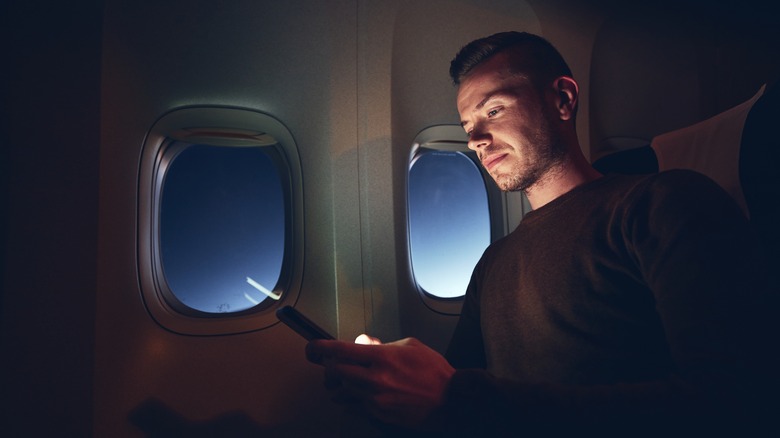The Real Reason Flight Attendants Dim The Cabin Lights At Critical Times
It's a familiar scene for most air travelers: Just as your plane is gearing up to hit the skies or come back down, the cabin lights dim significantly. And although plenty of passengers typically assume this routine measure is all a ploy to help them fall asleep comfortably during takeoff and landing (Spoiler alert: Flight attendants actively advise against sleeping during takeoff or landing), the real reason is a lot more practical — and potentially lifesaving too.
According to flight safety data from Boeing, takeoff/initial climb and final approach/landing generally present the highest risk of an accident happening, with 21% of fatal incidents occurring during the former and 43% during the latter. With that in mind, every safety measure counts during these crucial moments. And while learning to identify specific chime sounds you might hear on a plane is great, there are other protocols to know about — including something as simple as why flight attendants adjust the cabin lighting in different scenarios.
So, what's the exact purpose of dim lighting on a plane? Well, put simply, by dimming the lights and darkening the cabin, the crew is giving your eyes the opportunity to adjust to these new conditions, which will be incredibly helpful in case the worst does happen and you're forced to navigate the cabin in unfamiliar, lowlight conditions.
Dimming the lights helps your eyes adjust
The science behind this safety measure is pretty straightforward. Human eyes need time to adjust between bright and dark environments. So when an airplane's cabin lights are dimmed during, say, nighttime operations, the subtle change in lighting allows passengers' eyes to acclimate to these newly-darkened conditions — a process that would typically take between 20 and 30 minutes under normal circumstances.
Now, imagine you're on a flight that's forced to make an emergency landing. Considering most evacuation scenarios, this eyesight adjustment period then becomes especially important. Per the Flight Safety Foundation, passengers lose up to 83% of their navigational ability in smoky conditions — which can lead to dangerous confusion and costly delays when every second counts. That said, by ensuring that passengers have at least acclimatized their eyes to the dark, crews are essentially boosting passengers' ability to spot crucial emergency features a lot quicker and easier — from the illuminated exit signs to the floor-level light strip that'll guide their way to safety. Plus, considering the fact that the Federal Aviation Administration (FAA) imposes a standard that requires planes to be evacuated in 90 seconds, having passengers' eyes already adjusted to darkness could make the critical difference between life and death.
Other safety measures flight attendants take
While dimming the cabin lights is a crucial safety measure, it's just one of the many protocols that flight attendants must follow in order to ensure passenger safety. For example, during takeoff and landing, crew members will also require passengers to open their window shades. Annoying, sure — especially if you're sleeping or watching a movie — but this simple act is all for your own protection. After all, once the shades are up, flight attendants can spot any exterior hazards (think fire, debris, or damage) that could affect the evacuation process in case of an emergency.
The same goes for when flight attendants ask passengers to stow any tray tables or screens. Beyond trying to tidy things up, this is also done to help clear any obstacles or barriers that might prevent passengers from getting to an emergency exit quickly and unimpeded.
As for the request to return your seat to the upright position, this procedure actually has two purposes. First, upright seats are locked, which makes them better equipped to handle impact forces; meanwhile, reclined seats could dangerously shift, potentially leading to an accident. Second, having upright seats also ensures clear paths to the exits — similar to stowing tray tables — which is why, in most cases, seats located near or on an emergency exit row have limited or no recline at all.


